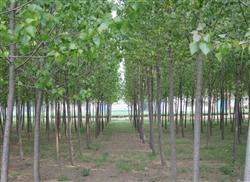Integrated control of poplar leaf-eating pests

Poplar is deeply loved by the people because of its fast-growing, suitable growth area, outstanding economic benefits and other excellent characteristics, but with the gradual expansion of poplar planting area, especially the development of pure forest area, the outbreak of poplar leaf-eating pests continues to occur, so the integrated control of poplar leaf-eating pests is very important. Species: the main poplar leaf-eating pests are poplar boat moth, poplar small boat moth, yellow-winged wild borer and poplar white moth. The first two species have 3-4 generations per year, and the latter two have 4 generations per year. Characteristics: the above four kinds of poplar leaf-eating pests have many generations every year, lay a large number of eggs, are clustered and eat a large amount of food, so they are very easy to break out in a short period of time (3-5 days), eating up the leaves and forming the misery of "summer and winter scenery". In addition, these four kinds of poplar leaf-eating pests damage for a long time, almost accompanied by the whole leaf growth period of poplar. Prevention and control measures 1. Build a mixed forest. Starting from the forest management measures combined with renewal cutting, it is appropriate to build a mixed forest, such as poplar and catalpa mixed, poplar and paulownia mixed, flake mixed forest. 2. Artificial prevention and cure. Cut off the bud in time, kill the larvae in the bract, or spray 2500 times of diflubenzuron suspension during the egg incubation period, with a dosage of 30g / mu. 3. Light trap. The adults can be trapped and killed by black light from the first ten days to the last ten days of July. 4. Biological control. Protect beneficial birds such as magpies, sparrows, rhododendrons, etc., spray with cyanobacteria or bt wettable powder, release Trichogramma (20, 000 ~ 40, 000 per mu) during the peak egg incubation period, and plant nectar plants such as rape around poplar forests to provide a suitable growth environment for natural enemies of leaf-eating pests such as Trichogramma, Ji wasps and ladybugs.
- Prev

Key points of cultivation techniques for fast-growing and high-yield poplar forest
In order to achieve fast growth, high yield, high quality and high efficiency of poplar, scientific cultivation techniques must be applied. According to the research results and practical experience of poplar cultivation techniques in our province, we should mainly master the following technical points: first, site selection. Selecting the forest land suitable for poplar growth is the basic rule to realize the rapid growth and high yield of poplar.
- Next

Fertilization technique of Poplar
Poplar skin rot (rot) mainly occurs on the trunk and branches of poplar. After the onset of the disease, the cortical tissue of the trunk and branches rotted, lost water, sunken, cracked, and smelled of wine lees. When the diseased part surrounds the trunk or branch for a week, the whole upper part of the tree dies. The disease occurs twice a year, when the temperature is above 7 ℃.
Related
- Fuxing push coffee new agricultural production and marketing class: lack of small-scale processing plants
- Jujube rice field leisure farm deep ploughing Yilan for five years to create a space for organic food and play
- Nongyu Farm-A trial of organic papaya for brave women with advanced technology
- Four points for attention in the prevention and control of diseases and insect pests of edible fungi
- How to add nutrient solution to Edible Fungi
- Is there any good way to control edible fungus mites?
- Open Inoculation Technology of Edible Fungi
- Is there any clever way to use fertilizer for edible fungus in winter?
- What agents are used to kill the pathogens of edible fungi in the mushroom shed?
- Rapid drying of Edible Fungi

